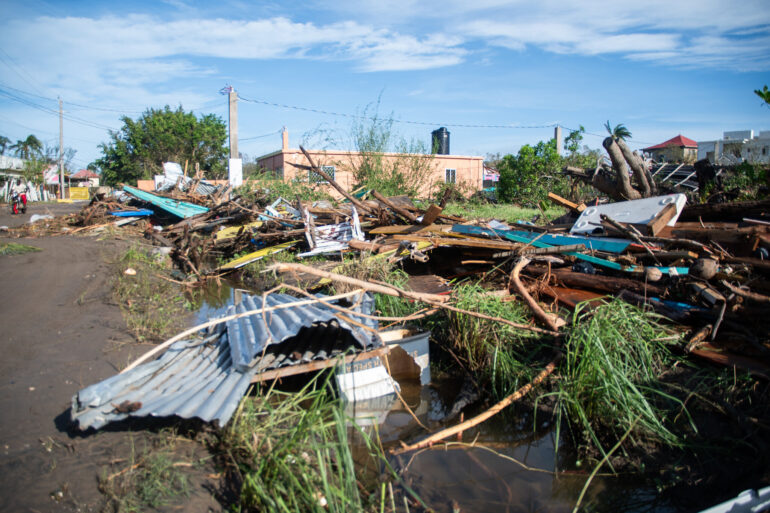Hurricane Melissa, one of the strongest Atlantic hurricanes on record, tore through Jamaica, Cuba, and Haiti this week, killing at least 34 people and leaving entire communities in ruins. The Category 5 storm made landfall in Jamaica on Tuesday with sustained winds of 185 mph, ripping roofs from homes, toppling power lines, and triggering massive flooding and landslides. As it weakened but continued its path, Melissa battered Cuba and caused deadly flooding in Haiti before moving into the Bahamas as a Category 1 hurricane on Wednesday night.
The storm’s fury has displaced hundreds of thousands, knocked out power for most of Jamaica, and destroyed historic towns. Officials warn that the full extent of the damage remains unclear due to widespread blackouts and blocked roads, but early reports describe “catastrophic” devastation unprecedented in the region’s history.
Jamaica Bears the Brunt of the Storm
Jamaica suffered the most direct hit when Melissa slammed into the island’s southwestern coast on Tuesday. With winds exceeding 185 mph, the hurricane flattened homes, uprooted trees, and surged seawater up to 16 feet in some areas. In Black River, a centuries-old port town in St. Elizabeth Parish with about 8,000 residents, the destruction was total. Satellite images show the once-vibrant coastline transformed into a muddy wasteland strewn with boulders, debris, and twisted metal.
“Only places that have four concrete walls are still standing, and usually their roofs are gone,” said Amiri Bradley, a visitor to Black River. The town’s hospital, fire station, courthouse, library, and historic Waterloo Guest House—Jamaica’s first home lit by electricity—were reduced to rubble. Mayor Richard Solomon called the scene “total devastation,” noting that emergency supplies stored in a container were swept away by floodwaters.
At least eight deaths have been confirmed in Jamaica, including five in St. Elizabeth Parish. One victim was a baby crushed by a falling tree, and pre-storm fatalities brought the island’s toll higher. Four bodies were found in southwest Jamaica, with police superintendent Coleridge Minto reporting that relatives walked 15 miles through blocked roads to report losses.
More than 25,000 people crowded into shelters, and over one million—about a third of Jamaica’s population—were directly affected, according to United Nations resident coordinator Dennis Zulu. Seventy-seven percent of the island lost power, creating a “total communication blackout” that hampered damage assessments. “Recovery will take time, but the government is fully mobilized,” Prime Minister Andrew Holness said. Two airports were set to reopen for relief flights on Wednesday, with commercial evacuations planned for Thursday. All 25,000 stranded tourists were accounted for and safe.
Residents like Jennifer Small in Santa Cruz described sweeping mud from homes and salvaging belongings amid roofless buildings and toppled utility poles. A landslide blocked main roads, turning streets into mud pits, and winds partially destroyed a high school used as a shelter. “I never see anything like this before in all my years living here,” Small said.
Deadly Flooding in Haiti Despite Indirect Hit
Even though Melissa did not make direct landfall in Haiti, its outer bands unleashed torrential rains that burst riverbanks and triggered deadly floods. At least 25 people died, including 10 children in the coastal town of Petit-Goâve, where the La Digue River overflowed. Dozens of homes collapsed, and 13 people remained missing nationwide.
In Petit-Goâve, lawyer Charly Saint-Vil walked streets littered with bodies and debris as families screamed for lost children. “People have lost everything,” he said. More than 160 homes were damaged and 80 destroyed in the town alone. Nationwide, over 1,000 homes flooded, displacing nearly 12,000 into shelters. Residents feared shortages of food, water, and medicine amid Haiti’s ongoing political instability. “We don’t know what will happen tomorrow,” Saint-Vil added, noting neighbors were sharing what little they had.
Three deaths were reported before the storm’s peak, and flooding hit areas like Les Cayes and Port-au-Prince, inundating even shelters for gang-displaced families.
Cuba Faces Widespread Ruin and Evacuations
After weakening from its Category 5 peak, Melissa struck eastern Cuba as a Category 3 storm, causing collapsed houses, blown-off roofs, and blocked mountain roads. The heaviest damage hit the southwest and northwest, with officials reporting no confirmed deaths but about 735,000 people still in shelters on Wednesday.
In Santiago de Cuba, resident Reinaldo Charon ventured out under a plastic sheet in lingering rain. “That was hell. All night long, it was terrible,” the 52-year-old said. Power outages persisted, complicating recovery. The U.S. Navy base at Guantánamo Bay lifted shelter-in-place orders after minor disruptions, with no injuries among its 3,000 residents or detainees.
Ongoing Threat in the Bahamas and Beyond
By Wednesday evening, Melissa had downgraded to a Category 1 with 90-100 mph winds but was churning through the southern Bahamas, bringing dangerous storm surges, heavy rains, and damaging winds. Officials urged residents to stay sheltered as tropical storm-force winds battered the islands. The storm was expected to pass near Bermuda by late Thursday, where a hurricane warning was issued.
One death was reported in the Dominican Republic from pre-storm debris cleanup. The U.S. State Department, under Secretary Marco Rubio, announced rescue teams and military assistance for the region. With USAID shuttered earlier this year, the military was tapped for relief efforts, including supplies prepositioned in warehouses.
A Storm of Historic Proportions
Hurricane Melissa ranks among the Atlantic’s most powerful, fueled by warm waters that amplified its intensity. Jamaica’s health ministry appealed for blood donations as hospitals operated in emergency mode. In Bermuda, thousands of Jamaican expats anxiously awaited news from home amid downed communications.
As cleanup begins, the Caribbean faces a long road to recovery. Governments, U.N. agencies, and nonprofits are mobilizing aid, but blocked infrastructure and blackouts mean many areas remain isolated. “We need all hands on deck,” said Jamaican Transportation Minister Daryl Vaz. For survivors picking through the wreckage, normalcy seems distant—but community resilience offers a glimmer of hope amid the chaos.
